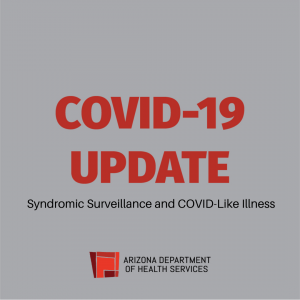 Public health utilizes several surveillance tools to monitor the spread of disease throughout a community. These tools, like case reporting, laboratory reporting, and syndromic surveillance, generate many of the data points that are displayed on our COVID-19 data dashboard. These surveillance tools are also used to monitor the metrics we use to set business reopening status and recommend education delivery models at schools.
Public health utilizes several surveillance tools to monitor the spread of disease throughout a community. These tools, like case reporting, laboratory reporting, and syndromic surveillance, generate many of the data points that are displayed on our COVID-19 data dashboard. These surveillance tools are also used to monitor the metrics we use to set business reopening status and recommend education delivery models at schools.
Lately, a lot of attention has been focused on syndromic surveillance, a surveillance tool behind the COVID-Like Illness metric, one of the three metrics informing our recommendations for business and school operations. Syndromic surveillance is a national tool that’s been in use by public health for years and was initiated in Arizona in 2014. It provides public health with the ability to rapidly detect and monitor health events by tracking symptoms of hospital patients. The data is automatically, electronically, and securely submitted at least daily (primarily hourly) through a healthcare facility’s electronic health record system. Syndromic surveillance data is pulled from multiple places in the patient’s electronic health record, including chief complaint, clinical impression, triage notes, diagnosis codes, travel history, demographics, and vitals.
In Arizona, 78 healthcare facilities across the state participate in syndromic surveillance. This represents 87% of all emergency departments and 90% of acute inpatient settings. Our Electronic Disease Surveillance Program facilitates a workgroup of state and local public health partners to identify ways to integrate syndromic surveillance across multiple public health programs and participates with national workgroups to learn and share best practices for use of syndromic surveillance data. The National Syndromic Surveillance Program at the Centers for Disease Control and Prevention (CDC) has experts at the national level who have been helping state and local public health utilize this data throughout the COVID-19 response.
In Arizona syndromic surveillance data is used for a number of public health initiatives outside of COVID-19, including the following:
- Detecting, understanding, and monitoring, new and emerging public health events like vaping product-associated lung injury and Zika,
- Monitoring influenza-like Illness during flu season and identifying hospital surge concerns,
- Monitoring and alerting for opioids and other drug overdoses so that public health can take action in a timely way,
- Monitoring heat-related illness to determine if cooling centers should be opened and providing educational resources to the public,
- Use during natural disasters like hurricanes, wildfires, and flooding to detect increases in carbon monoxide poisonings and disseminate communication not to use generators indoors, and for increasing visits to Emergency Departments for medication refills and chronic diseases during or after the storm, and
- Monitoring mass gathering events like presidential visits, sporting events like Super Bowl, and music festivals as an early detection tool for disease or bioterrorism.
Early in the COVID-19 response, when testing was not widely available, a syndrome for COVID-Like Illness was adopted nationally to allow for early monitoring of COVID-19 across the country. This allowed local, state, and federal partners to monitor disease spread in the absence of other traditional data sources like reliable case and laboratory reporting. You can find weekly syndromic surveillance for COVID-Like Illness reported on the Hospital COVID-like & Influenza-like illness Surveillance section of our Data Dashboard. COVID-Like Illness visits are displayed as a percentage of total hospital visits by week and monitored for trends. Importantly, influenza diagnosis codes are excluded in the syndrome definition for COVID-Like Illness. This Arizona COVID-Like Illness data closely mirrors the trends we saw in self-reports from hospitals and case and laboratory reporting as these reporting systems became more robust over time.
When public health established school and business benchmarks, we identified the importance of monitoring metrics that provided insight into the burden of disease in a community – case rates, degree of community spread – percent positivity, and healthcare system utilization – COVID-Like Illness visits. While there are alternate metrics that could also provide insight into healthcare system impact, public health experts ultimately selected the COVID-Like Illness metric as the most reliable metric because it is not dependent upon availability of testing, is not self-reported, and has proven to consistently track hospital utilization due to COVID-19 throughout the pandemic. In fact, reviewing our data has shown that COVID-Like Illness is a leading indicator and more sensitive, showing increases in hospital utilization several days earlier when compared to the self-reported Hospital COVID-19 Specific Metrics.
Our primary focus is the health of Arizonans and supporting our healthcare system. Syndromic surveillance gives us a real-time look at the impact COVID-19 is having on our emergency departments and inpatient units, and it provides public health with reliable data to inform recommendations and to make decisions.









